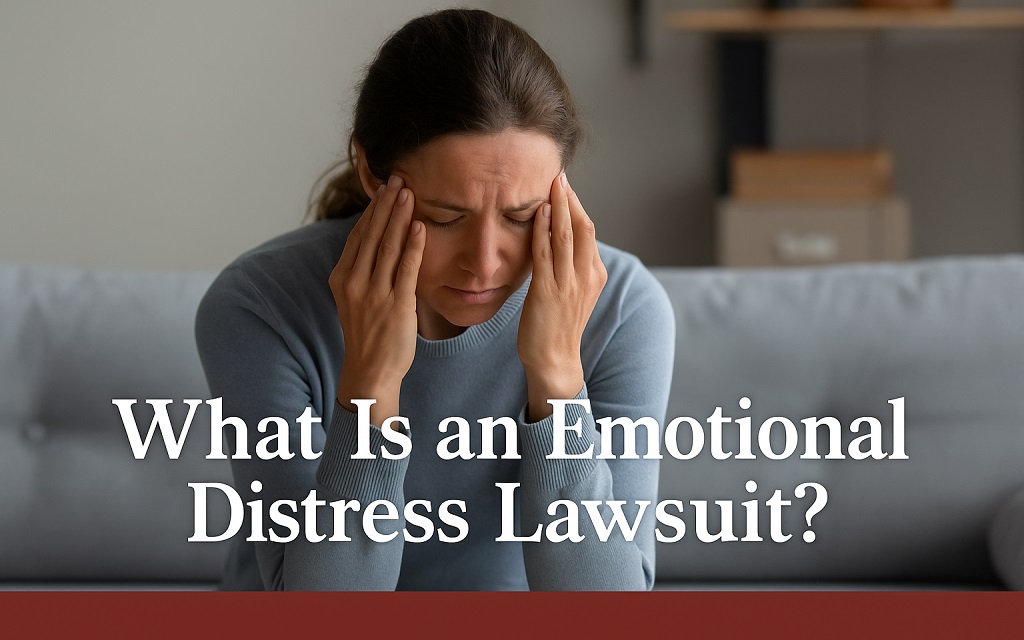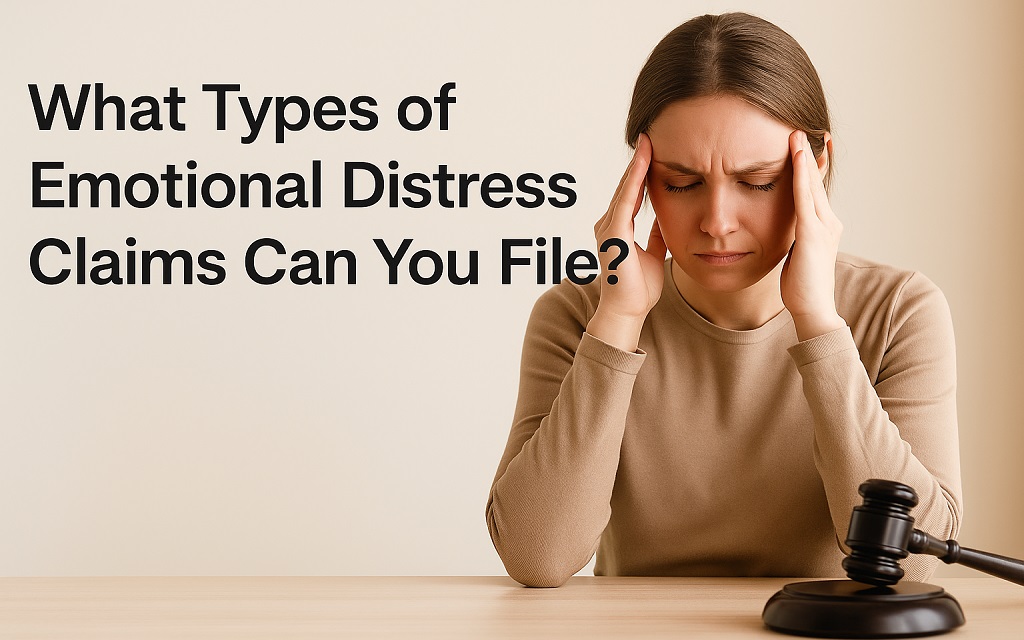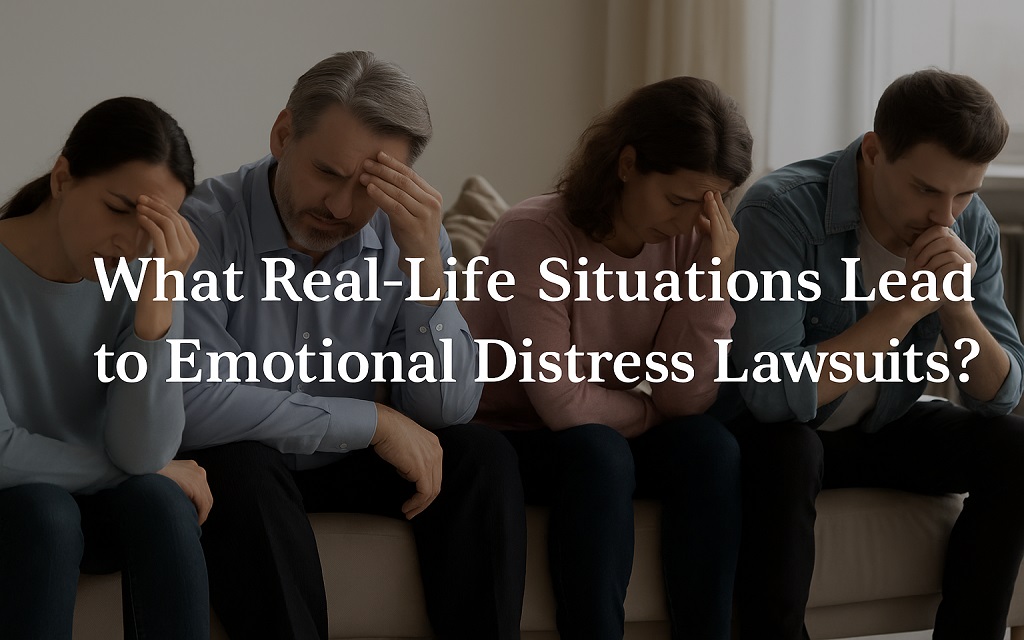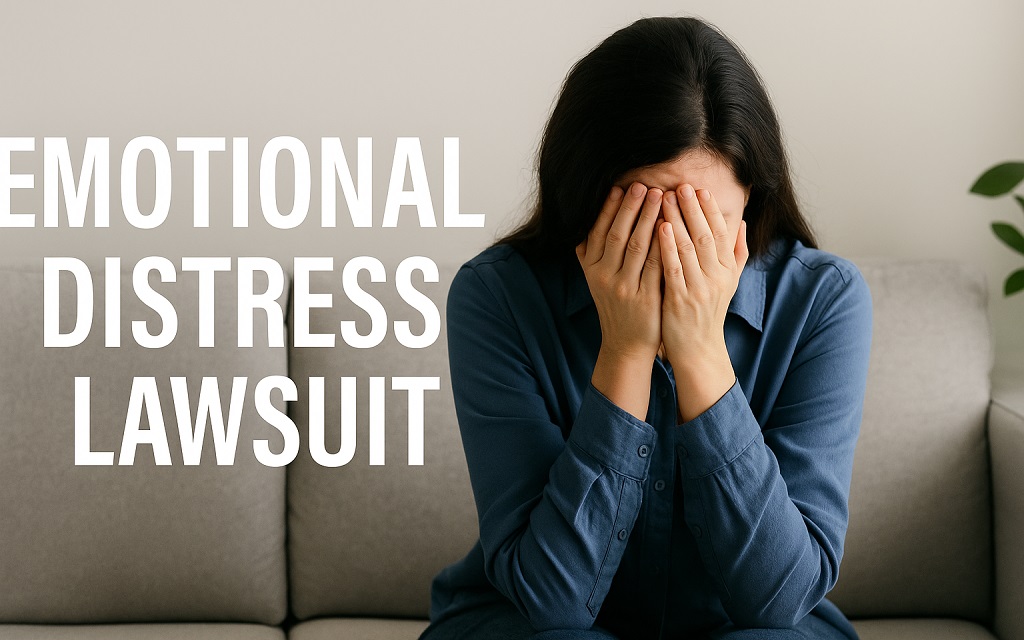Just like physical injuries, emotional agony has the power to alter one’s life. Following a traumatic experience, anxiety, sadness, or post-traumatic stress disorder may have an impact on your relationships, career, and health. The law offers you a route to justice through an emotional distress lawsuit when that suffering is caused by the carelessness or deliberate action of another person. You may wonder how an Emotional Distress Lawsuit works.
If you did not have an apparent injury, can you still file a lawsuit? What proof is required to persuade a jury or judge? What kind of restitution are you likely to receive for the injuries you suffered? People frequently ask these questions when they start thinking about filing a lawsuit for psychological damage. You can get compensation for significant mental suffering that is medically proven and directly related to the defendant’s actions by filing an emotional distress lawsuit.
However, victims of illnesses, including PTSD, anxiety disorders, and chronic depression, have received compensation from the courts. Being aware of your rights enables you to act appropriately when necessary. Every facet of an emotional distress lawsuit is covered in this guide. Definitions, legal requirements, compensation ranges, case studies, and the claim-filing procedure will all be covered so you may make well-informed judgments in the future.
What Is an Emotional Distress Lawsuit?

A civil case for emotional distress is filed to obtain compensation for psychological suffering. If you suffered mental distress as a result of carelessness or deliberate wrongdoing, you could be eligible to petition. Courts refer to mental anguish like anxiety, embarrassment, sadness, or PTSD as “emotional distress.”
It is essential to know that emotional distress must meet strict criteria. Courts require proof that the harm is severe. They demand credible documentation. They also require a direct link between the defendant’s conduct and your suffering. Ordinary stress or sadness does not qualify. Judges look for cases where mental harm disrupts everyday life.
The legal distinction between emotional and physical injury influences how claims are handled. A broken arm shows up on an X-ray. Emotional pain leaves no visible mark. Courts, therefore, depend on psychiatric records, therapy notes, and testimony. For example, a patient taking antidepressants after workplace harassment can use prescription records to prove the severity.
Case law confirms this principle. In Molien v. Kaiser Foundation Hospitals (1980), the California Supreme Court allowed recovery for negligent infliction of emotional distress without physical injury. The court accepted that psychological harm could stand as an independent injury. That ruling set a precedent for many states.
Statistics also support the need for recognition. The National Institute of Mental Health reports that nearly 22 percent of U.S. adults experience mental illness in a given year. Severe cases often result from trauma caused by negligence or abuse—emotional distress lawsuits address that reality by creating accountability and recovery.
What Types of Emotional Distress Claims Can You File?

Courts divide emotional distress lawsuits into two categories. You should know the difference to understand your legal path.
What Is Intentional Infliction of Emotional Distress (IIED)?
You can sue under IIED when the defendant acted with the intent to cause harm. Courts demand proof of extreme and outrageous conduct. The law sets a high standard. Rude or careless words are not enough. Conduct must shock the conscience of society.
You must also prove that the defendant acted with intent or reckless disregard for your well-being. In addition, you must show that the harm was severe. However, temporary embarrassment or frustration does not qualify. For example, repeated sexual harassment by a supervisor with the intent to humiliate may justify an IIED claim.
Courts have awarded damages in such cases. In Alcorn v. Anbro Engineering, Inc. (1970), the California Supreme Court recognized IIED when an employer used racial slurs and humiliation. The court ruled that extreme verbal abuse justified recovery.
What Is Negligent Infliction of Emotional Distress (NIED)?
NIED applies when emotional harm comes from negligence rather than intent. You must prove that the conduct created a foreseeable risk of psychological injury.
States apply different rules. Under the zone of danger rule, you must show that you were at immediate risk of physical harm. For example, if a speeding car nearly struck you, the resulting anxiety may justify a claim.
However, some states allow bystander claims. You may recover damages if you witnessed harm to a close family member. A mother who saw her child injured in an accident may qualify. Courts require proof of a close relationship and severe distress.
Dillon v. Legg (1968), in which the California Supreme Court allowed a mother to file a lawsuit after seeing her child die in an automobile accident, is a well-known case. Despite the mother’s lack of bodily suffering, the court acknowledged emotional harm.
Must Read: Massage Envy Lawsuit | Sexual Assault Claims, ADA Violations & Rights
What Real-Life Situations Lead to Emotional Distress Lawsuits?

You may ask what events typically lead to lawsuits. Courts recognize several common scenarios.
- Harassment at work results in extreme embarrassment and worry. Employees frequently bring lawsuits under employment and tort law. Nearly one-third of all employment discrimination lawsuits involve harassment accusations, according to the Equal Employment Opportunity Commission (EEOC).
- Patients and their families experience emotional anguish as a result of medical misconduct. For instance, hospitals are frequently sued by parents who have been traumatized by delivery injuries. Verdicts have reached millions when evidence shows severe trauma.
- Even when there are just minor physical injuries, car accidents can cause PTSD. According to the National Center for PTSD, the most common cause of PTSD in Americans who are not in the military is auto accidents.
- Family members’ claims of emotional suffering are frequently included in wrongful death cases. For psychological suffering, anguish, and bereavement, courts grant damages.
Each example shows that emotional distress spans many fields of law. You may file under torts, medical malpractice, or employment law.
However, statistics show the scale. A 2021 Bureau of Justice Statistics report found that nearly 25 percent of personal injury lawsuits included claims for emotional harm. Courts now accept that trauma deserves the same legal respect as visible injury.
What Do Courts Require to Prove Emotional Distress?
You should know that courts demand strict elements. Without proof, your claim will fail.
First, you must prove the defendant owed you a duty of care. Second, you must show that the duty was breached. Third, you must establish that the breach caused your emotional harm. Fourth, you must prove that the damage is severe and medically supported.
You may ask what qualifies as emotional distress in court. Judges recognize conditions such as PTSD, major depression, or anxiety disorder. Temporary stress from daily frustration does not qualify. You need medical diagnosis and therapy documentation.
However, defendants use common defenses. They argue that your harm is exaggerated. They may point to pre-existing mental health conditions. In addition, they say that their conduct was not extreme enough to qualify.
However, courts require documentation to overcome those arguments. Psychiatric evaluations, therapy records, and medication history provide credibility. Expert testimony explains the severity to jurors. Without such evidence, jurors may remain skeptical.
Case examples confirm the rule. In GTE Southwest, Inc. v. Bruce (1999), the Texas Supreme Court recognized IIED after employees suffered severe psychological trauma due to extreme harassment by a supervisor. Evidence of therapy and expert testimony secured the verdict.
How Can You File an Emotional Distress Lawsuit?
You should follow a structured process when filing. Each stage matters for success.
- Consult an attorney who specializes in emotional distress claims.
- Collect therapy notes, psychiatric evaluations, and witness statements.
- File the legal complaint in the proper court jurisdiction.
- Participate in discovery where both sides exchange evidence.
- Negotiate a settlement or prepare for trial.
Statutes of limitations set strict deadlines. Most states limit emotional distress lawsuits to one to three years from the event. Missing the deadline ends your right to sue. For example, California allows two years for personal injury lawsuits, including emotional distress. New York allows three years.
However, venue also matters. You must file in the state where the event occurred or where the defendant resides. The choice affects jury attitudes and compensation rules. Lawyers often select venues strategically to improve outcomes.
However, court procedure takes time. Studies by the National Center for State Courts show that personal injury lawsuits take an average of 22 months from filing to disposition. You should prepare for that timeline.
How Do You Prove Emotional Distress in Court?
Proof is the hardest part of an emotional distress lawsuit. Courts require multiple forms of evidence.
- Medical records confirm diagnoses such as PTSD or depression.
- Therapy notes show ongoing treatment.
- Prescription records prove severe conditions.
- Expert testimony explains the impact on your life.
- Witness statements support credibility.
- Personal journals document daily struggles.
Courts give high weight to objective medical documentation. Psychiatric evaluations are often decisive. Experts explain psychological harm to jurors in clear terms. Witnesses help confirm lifestyle changes.
However, challenges remain. Jurors may doubt claims without physical injury. Defendants argue exaggeration or unrelated causes. Pre-existing conditions weaken cases. Strong, consistent records counter those defenses.
Case examples prove the importance of evidence. In Thing v. La Chusa (1989), the California Supreme Court limited bystander claims but emphasized the need for proof of close relationship, presence at the scene, and severe harm. Evidence standards remain strict.
How Much Compensation Can You Get in an Emotional Distress Lawsuit?
You may ask how much money you can recover. Compensation varies widely.
Courts divide damages into economic and non-economic categories. Economic damages cover therapy bills, medication, and lost wages. Non-economic damages cover pain, suffering, and loss of enjoyment of life.
Settlement values differ:
- Minor cases may recover $5,000 to $25,000
- Moderate cases may recover $30,000 to $100,000
- Severe cases with PTSD may exceed $500,000
- Catastrophic cases with lasting harm may reach millions
Data confirms variation. VerdictSearch, a legal database, reports that emotional distress awards in medical malpractice cases often exceed $1 million when harm is permanent.
Anyhow, state rules also affect awards. California caps non-economic damages at $250,000 in medical malpractice cases. Colorado caps at $500,000 unless evidence justifies more. Nebraska caps at $1.25 million.
Factors influencing awards include severity, medical evidence, and defendant conduct. However, outrageous actions often increase damages. Strong documentation improves recovery.
What Challenges Do You Face in Winning an Emotional Distress Lawsuit?
You must recognize the obstacles before filing. Emotional distress lawsuits face skepticism.
Proof is subjective. Jurors struggle to measure psychological harm. Courts set high standards for severity. Defendants often argue exaggeration. Insurance companies resist paying.
Common mistakes harm cases. Delaying medical care reduces credibility. Relying only on personal accounts weakens the proof. Filing after the deadline eliminates rights.
However, insurance companies use defense tactics. They argue the harm is unrelated. They search social media for evidence against the plaintiffs. Additionally, they push for low settlements.
Therefore, the best strategy is preparation. You should seek treatment immediately, maintain therapy records, and work with an experienced attorney. Statistics show that represented plaintiffs win higher settlements. The Insurance Research Council reports that settlements are nearly three times higher with legal counsel.
How Do State Laws Differ for Emotional Distress Lawsuits?
State rules create significant differences. You should learn how your state treats claims.
Some states use the impact rule. Florida, Georgia, and Kentucky require proof of physical impact before emotional distress recovery.
However, other states apply the zone of danger test. New York, Illinois, and Pennsylvania allow recovery if you were at immediate risk of physical harm.
Some states recognize bystander recovery. California, Texas, and Washington allow claims if you witnessed injury to a close relative. Courts require proof of presence, relationship, and severe distress.
Damage caps also differ. California caps medical malpractice at $250,000. Colorado sets $500,000 unless clear evidence justifies more. Nebraska caps at $1.25 million. Some states impose no cap.
However, jurisdiction can determine outcomes. You should consult an attorney in your state for precise rules.
Must Read: Chime Class Action Lawsuit: What You Need to Know
Can You File Emotional Distress Lawsuits in Family Law Cases?
You may wonder if family disputes qualify. Emotional harm often arises in divorce, custody, or domestic violence.
Divorce alone does not justify claims. You may sue if a spouse engages in intentional misconduct. For example, spreading false allegations that cause depression may form an IIED claim.
Custody disputes may include claims if one parent acts maliciously. False abuse claims that damage parental rights may qualify. Courts remain cautious but allow lawsuits in extreme cases.
However, domestic violence often justifies both physical and emotional claims. Victims may claim PTSD, anxiety, and depression. Courts accept such claims with psychiatric proof.
Family law emotional distress claims remain limited. However, courts avoid turning ordinary disputes into torts. Only severe and outrageous conduct qualifies.
What Case Studies Show Emotional Distress Lawsuit Outcomes?
Case studies illustrate real outcomes.
- A harassment case in Texas led to a $500,000 settlement. Therapy records proved anxiety and depression.
- A birth injury case in California led to a $2.5 million award for parents traumatized by negligence.
- A drunk driving victim in New Jersey developed PTSD and settled for $100,000 despite minor physical injuries.
However, data confirms patterns. Jury Verdict Research reports median awards for emotional distress at $100,000 in personal injury cases. Severe trauma produces higher awards. Evidence strength remains decisive.
How Long Does an Emotional Distress Lawsuit Take?
You may ask about the duration. Lawsuits often last one to two years.
- Attorney consultation may take weeks
- Filing may take one month
- Discovery may take nine months
- Motions may take three months
- Negotiations continue throughout
- Trial may last weeks
- Appeals may follow verdicts
National Center for State Courts data shows an average of 22 months for personal injury cases. Many claims settle earlier. Settlements save time and reduce stress.
However, patience matters. You should prepare for delays and maintain documentation. Consistency supports credibility.
FAQs
In a lawsuit, how can emotional suffering be proven?
Expert testimony, therapy notes, and medical records are required. Courts need unmistakable proof that the defendant’s actions are to blame for the extreme anguish.
How much may you sue someone for emotional distress?
Although there is no upper limit, catastrophic cases can amount to millions. State regulations and damage restrictions may limit non-economic compensation.
How much can I be compensated for experiencing emotional distress?
$5,000–$25,000 for minor cases, $30,000–$100,000 for moderate situations, and $500,000 or more for severe cases. Jurisdiction and evidence determine settlement.
How can one demonstrate that someone is experiencing emotional distress?
Psychiatric exams, therapy notes, medication histories, and witness statements are all sources of proof. Maintaining accurate medical records is essential.
What proof is there for emotional distress?
Witness testimony, medication records, therapy records, psychiatric reports, and personal journals provide strong evidence.
How may emotional distress be claimed?
You should obtain treatment and medical records, speak with an attorney, and submit a complaint within your state’s statute of limitations.
Final Words
To put it briefly, you should acknowledge that emotional suffering is worthy of justice. An emotional distress lawsuit for mental anguish provides a means to obtain compensation. Strong proof, medical records, and legal advice are necessary for success.
But even though you can feel overpowered, knowledgeable lawyers can help. You safeguard your rights by taking prompt action, filing accurately, and providing solid evidence. Emotional distress lawsuits offer you a fair opportunity at recovery by transforming invisible pain into recognized damage.
Disclaimer: This article provides a general overview of the emotional distress lawsuit, based on publicly available information, and is intended for informational purposes only. It does not provide legal advice. You must consult a licensed attorney for any legal decisions.



![Read more about the article Miracle Moo Lawsuit: False Supplement Claims, Legal Rights & Class Action Explained [2025 Update]](https://www.judicialocean.com/wp-content/uploads/2025/10/Miracle-Moo-Lawsuit-1-768x480.jpg)
